
How to write your CV education section + examples
Your education section of your CV is crucial part of the document.
But it can be tough to know to write, where to put it, and what you should include.
This guide will show you exactly how to write an impressive education section for your own CV, whether you are a school leaver, experienced professional, or anything in between.
Where to put your education on your CV?
Where you position your education section on your CV will largely depend on your level of experience and how long ago you left full-time education.
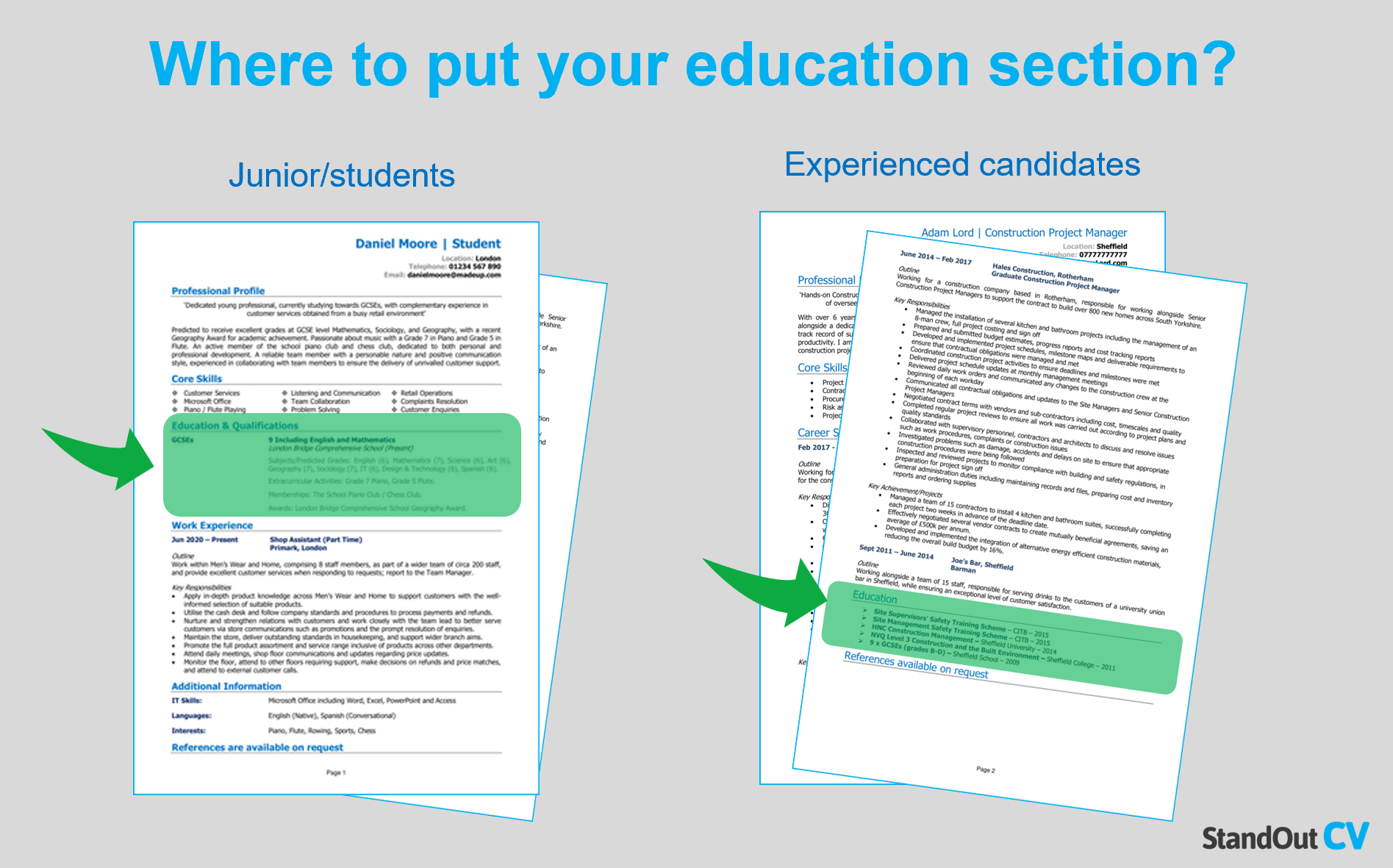
- Little/no experience – If you’re just leaving education and therefore don’t have a lot of experience behind you, place your education section nearer the top of your CV, under your personal profile . Be sure to go into plenty of detail because, at this point in your career, your academic record will receive more attention, and employers will need lots of info to be persuaded to hire you.
- Experienced candidate – If you’re a more experienced candidate who has gained skills and knowledge through past positions, your employment history takes precedence. In this case, your education section should go under your employment section because employers are likely to be more interested in your real-world experience – although they will still value your education.
CV templates
What to include in your education section?
This section should outline your formal education, qualifications and certificates in reverse chronological order. Here’s an overview of what this might include:
- Degree – As a university graduate, you need to include your degree , and if you’ve got post-graduate qualifications, your most recent degree must come first. To do this, include the name of the university, the title of your degree, the dates you studied there and the grade you received. You might also wish to include details of any relevant modules you studied
- A-levels – If you took A-levels at college, you probably completed three to four subjects. Be sure to include the name of your college, the dates you studied there and the subjects you completed.
- Vocational qualifications – School or college aren’t the end of the road for your education but if you chose not to study a degree, you may have obtained other vocational qualifications. If so, you need to include these too. Follow the same formatting rules by including the name of the institution, the qualification and the date you achieved it
- GCSEs – Listing your GCSEs can be trickier as there are often more of these. So if you have lots of GCSEs, include your school name, the years you were there and then abbreviate your list of subjects. For example, ‘10 GCSEs including maths and English’
- Mandatory certificates – There might be mandatory training you need to undertake to get a job, for example, health and safety certificates. In this case, you should include these in your education section, listing the level of certification, name of the course and date you received it. You might also wish to include the name of the accrediting body if they are well-known in the industry.
Education section examples
Now you have a better understanding of what could be included in your education section, let’s take a closer look at how these should be written with some examples.
School leaver
As a school leaver hoping to land a job, it’s likely that your GCSEs are going to be your highest level of qualification.
When adding these to your CV, you should include the full name of your school and the dates you attended. Underneath this, you can begin to outline your GCSEs.
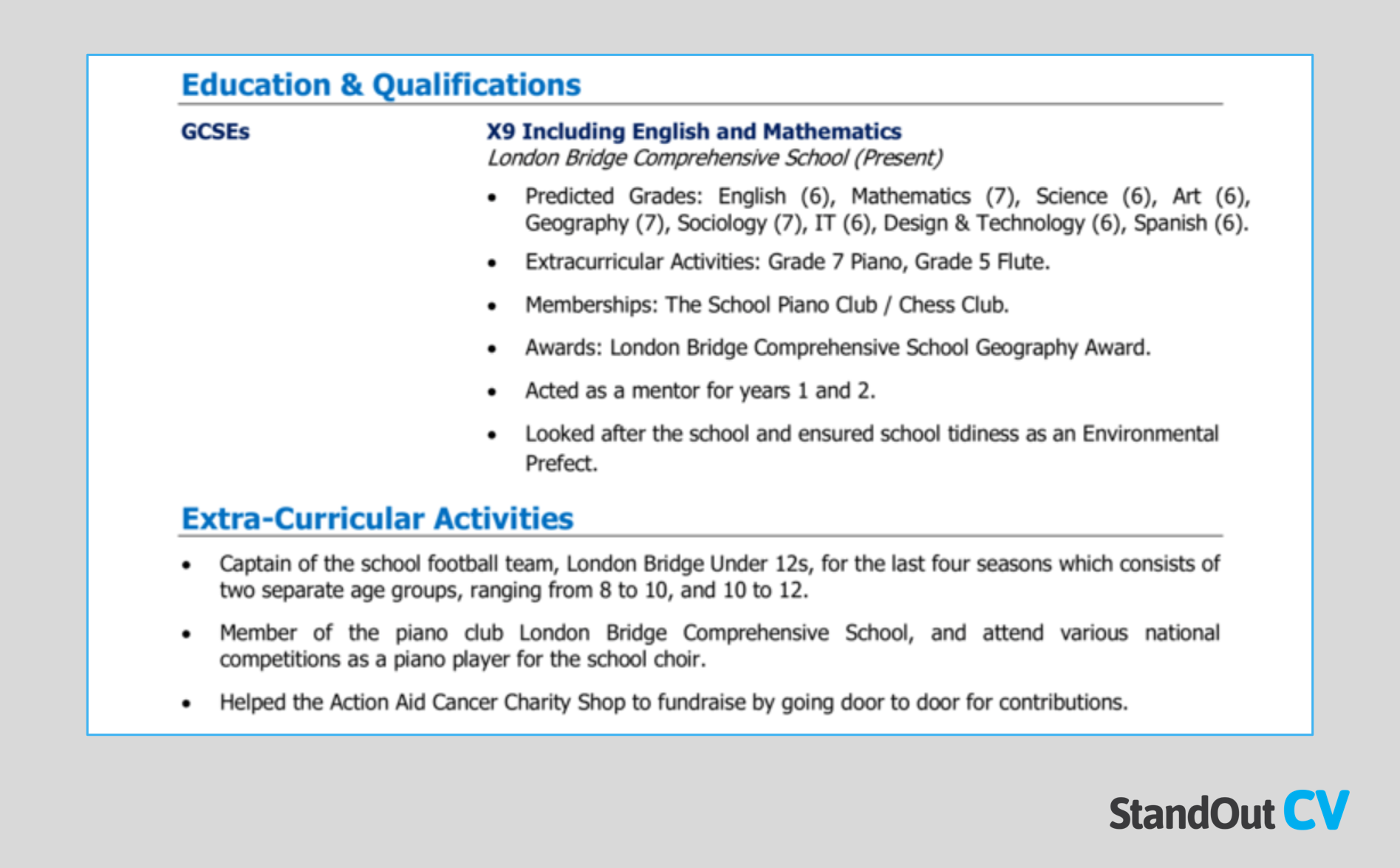
Baxton Hill High School – 2014 to 2019 10 GCSEs
- English (A) | Language & Literature
- Maths (A) | Achieved best coursework award
- Biology (B)
- Physics (B)
- Chemistry (B)
- Information Technology (A) | Specialised in Microsoft Office
- Geography (C)
Extracurricular activities and achievements:
- Grade 5 piano
- Grade 3 flute
- Captain of the school hockey team
- Voted ‘Most Spectacular Sportsperson of the Year’ in Year 10 and 11
Because this makes up the basis of your educational background, you can afford to outline all of your subjects and grades in more detail.
You could also include any awards or clubs in which you participated, it might look a little something like the above.

College leaver
As a college leaver, you will still need to include your GCSEs, particularly if they are relevant to the role you’re applying for, but your main focus should be on your more recent A-Levels.
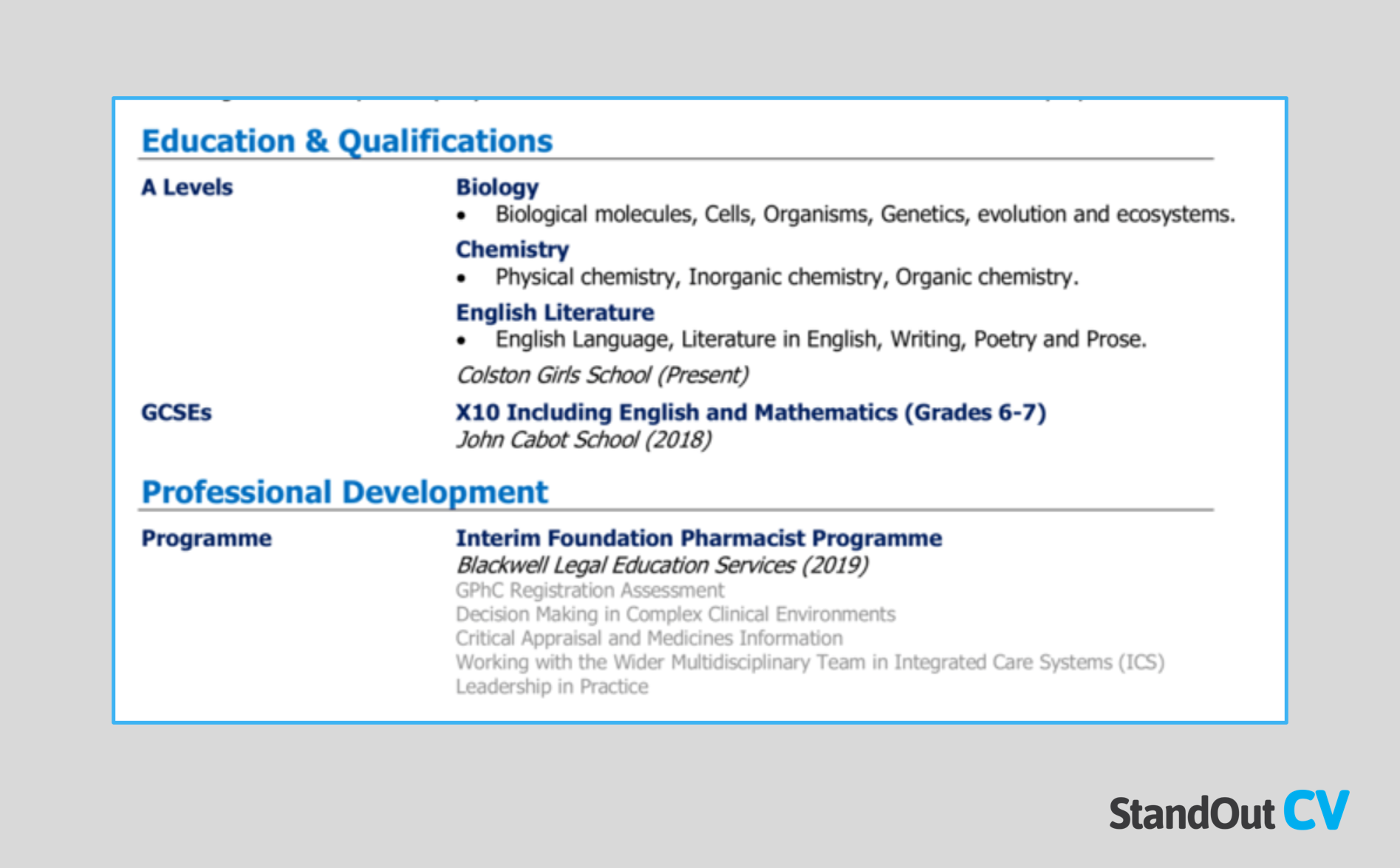
London Central College – 2019 to 2021 3 A-Levels
- Photography (A) | Including wildlife photography project and paper
- English Language (A) | Studying “Of Mice and Men”
- Graphic Design (B) | Completed a complete product design of a toy package
Achievements
- Practical experience in Adobe Photoshop, Illustrator and InDesign
- Proficient using DLSR camera, as well as experience developing film in the darkroom
- Achieved A grade and finished in top 10% of my class for print media and photography project
Baxton Hill High School – 2014 to 2019
10 GCSEs grade A to C including English, Maths, IT and Art
As you study fewer subjects at A-Level (typically three to four), you can give a bit more detail about each subject, your grades and anything else that could boost your application.
For example , you could outline particular projects that you were proud of or some of your key achievements. In this case, your education section might look a little something like the above.
Experienced professional
After college, or perhaps even during your time at college, you may have chosen to undertake a vocational qualification as a way of boosting your skills and gaining some real-world experience. This could be in the form of an NVQ , BTEC or a diploma.

City & Guilds NVQ (L1) in Hospitality Skills – 2020 – 2021
- Learning to maintain a safe, hygienic and secure working environment
- Working with the team to prepare, cook and safely store food
- Industry-standard training in kitchens and restaurants around London
London Central College – 2018 to 2020
A-Levels including English Language (A), Business Studies (A) and Food Science (B)
Baxton Hill High School – 2013 to 2018
10 GCSEs grade A to C including English, Maths and Food Technology
So although your experience in the workplace will likely take precedent on your CV, your education section is still important, and you need to give a little more detail about your vocational qualifications.
You can still include any A-Levels you have as well as GCSEs, but these should be kept to brief summaries like the above.
Recent Graduate
As a recent graduate , your degree is going to be one of your key selling points, particularly if you don’t have a great deal of work experience behind you.
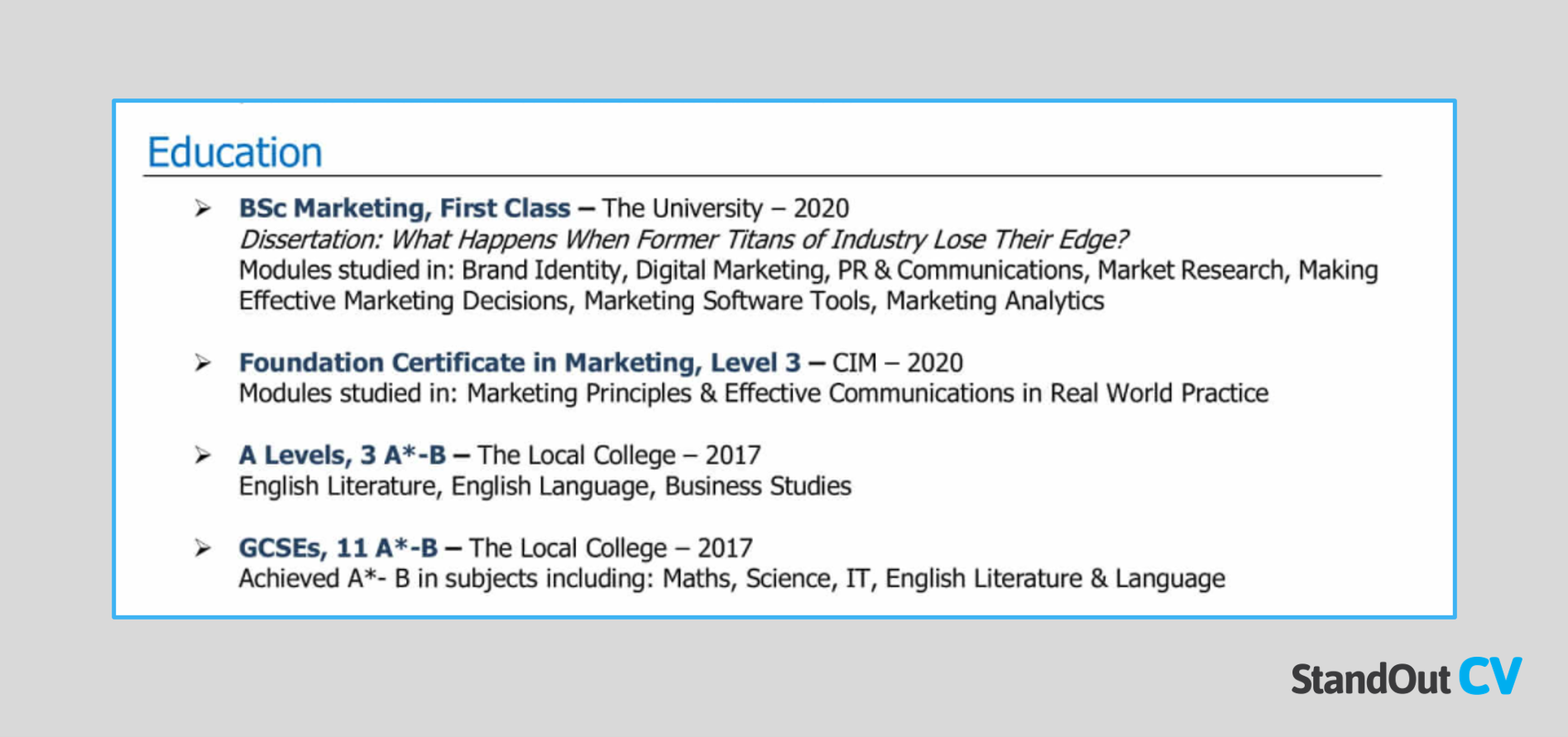
BSc (Hons) Computer Science – Queen Mary University – 2018 – 2021 Final grade: 1st Class
- Modules including: Big data processing, data mining, Artificial Intelligence (AI) and algorithms and data structures
- Achieved a 1st (96%) for my dissertation on ‘issues with privacy and security when dealing with big data’, coming top of my class
- Gained practical experience in software engineering, procedural programming and data mining
A-Levels including Information Technology (A), Business Studies (A) and Graphic Design (B)
10 GCSEs grade A to C including English, Maths and IT
You will still need to include your A-Levels and GCEs, but these sections don’t need to contain as much detail. Your focus should be on showcasing your degree, the key skills you gained and any achievements during your studies. You might also include any modules you studied that are relevant to the role.
The format should include the type of degree, as well as the full title, and you should include any honours along with your final grade.
Experienced Graduate
If you are a graduate with experience, whether that is because you left university a few years back or because you undertook a work placement as part of your course, this section can be less detailed.

BA (Hons) Digital Marketing – Queen Mary University – 2018 – 2021 Final grade: 2:1
- Modules including: Interactive media technologies, media streaming and the Cloud, programming for data analysis and personalising the digital experience
A-Levels including English Language (A), Media Studies(A) and History (B)
10 GCSEs grade A to C including English, Maths and Media Studies
You should still include your degree, A-Levels and GCSEs as shown above, but you can give fewer details, as the focus will lie with your real-world experience.
That said, this section should follow a similar format, including the type of degree and the full title, the university you attended and your final grade. In this case, your education section might look something like the above.
How to write your education on your CV
No matter what stage you’re at in your career, knowing how to structure , format and effectively showcase your education on your CV is critical. To help you get it right, we have pulled together some of our top tips for nailing your education section.
Adapt for your experience level
As we mentioned earlier, you should always include your educational experience in reverse chronological order, listing your most recent qualifications first. You also need to adapt this section depending on your level of experience.
You can see in the examples we’ve given above, if you’ve got work experience behind you, then you can afford to be more sparing on the details. However, if you don’t have a lot of relevant experience to speak of, you should go more in-depth about your key subjects, skills and achievements in your education section.
Only include relevant qualifications
As with every section on your CV, you need to make sure that you’re only providing information that is relevant to the role and employer. Otherwise, you could be wasting valuable space.
The more experience you have behind you, the less detail you need to give in terms of your education. Therefore, you can leave out any qualifications that aren’t relevant to the role. This is the reason you don’t need to list all 10 of your GCSEs unless this is the only educational background you have.
The same applies when you include your modules, achievements or extra-curricular activities. If they aren’t relevant to your career path, you are better off saving that space for something that is.
Use bullet points and break information up
Finally, it can be helpful to use bullet points throughout your education section, particularly when going into more detail about your experience. This is because bullet points can improve the format, make your CV more readable and help draw the recruiter’s attention to the details that matter the most.
Remember, you only have a few seconds to grab their attention and impress them, so you need to make it as easy as possible for the reader to find the key information quickly and effortlessly.
3 Education CV Examples [+ Template]
Educators are the architects of knowledge, carefully constructing lessons that inspire, challenge, and enlighten their students. A well-structured Education CV, much like a teacher's lesson plan, should demonstrate this same level of thoughtful preparation and dedication to fostering growth. <br><br> In this guide, we'll delve into compelling Education CV examples that highlight your pedagogical prowess and commitment to creating enriching learning environments.

CV Examples
Cv guidance.
- Essential Sections
Optional Sections
- Getting the CV Structure Right
- Formatting Your CV
- Personal Statements for Education
- CV Experience
- CV Skills & Proficiencies
- How to Tailor Your CV to a Job
- FAQs about CVs
- Related CVs
CV Writing for Educations
- Highlight Your Qualifications and Specialization : Specify qualifications like B.Ed, M.Ed, or PhD. Detail specializations such as early childhood education, special education, or subject-specific teaching early on in your CV.
- Quantify Your Impact : Share achievements with numbers, like a 20% improvement in student grades or a 30% increase in student participation.
- Tailor Your CV to the Job Description : Match your CV content to the job's needs, highlighting relevant experiences like curriculum development or classroom management if emphasized by the employer.
- Detail Your Tech Proficiency : List proficiency in educational software like Google Classroom, Blackboard, or Moodle, and any experience with online teaching tools. These matter.
- Showcase Soft Skills and Leadership : Briefly mention leadership, teamwork, or your ability to inspire and motivate students.
The Smarter, Faster Way to Write Your CV

Education CV Example
- Implemented a new curriculum design that increased student engagement by 30%, leading to a significant improvement in overall academic performance.
- Developed and executed a comprehensive teacher training program, resulting in a 20% increase in teaching efficiency and a 15% improvement in student satisfaction rates.
- Introduced innovative technology into the classroom, enhancing the learning experience and increasing student tech proficiency by 40%.
- Managed a team of 10 educators, fostering a collaborative environment that led to a 25% increase in team productivity and a 15% improvement in student outcomes.
- Implemented a school-wide literacy initiative that improved reading levels by 30%, contributing to higher standardized test scores.
- Developed and enforced a positive behavior support system, reducing disciplinary incidents by 20% and creating a safer, more inclusive learning environment.
- Designed and implemented differentiated instruction strategies, catering to diverse learning needs and leading to a 20% increase in student comprehension.
- Collaborated with parents and guardians to create individualized learning plans, resulting in a 15% improvement in student performance.
- Initiated a peer mentoring program that improved student relationships, increased collaboration, and boosted overall student morale.
- Curriculum Development
- Teacher Training
- Technology Integration
- Team Management
- Literacy Program Implementation
- Positive Behavior Support
- Differentiated Instruction
- Parent-Teacher Collaboration
- Individualized Learning Plan Creation
- Peer Mentoring Program Development
Physical Education CV Example
- Developed and implemented a comprehensive physical education curriculum that increased student participation by 30%, promoting a healthy lifestyle and fostering a love for physical activity.
- Coordinated a school-wide fitness challenge that engaged 90% of students, leading to an overall improvement in fitness levels and a 15% decrease in obesity rates.
- Introduced a variety of new sports and activities, resulting in a 20% increase in student interest and participation in extracurricular sports clubs.
- Implemented an innovative assessment system that tracked student progress in physical education, leading to a 25% improvement in student performance over the academic year.
- Organized and led a successful annual sports day event, fostering school spirit and encouraging 100% student participation.
- Collaborated with classroom teachers to integrate physical education into daily lessons, resulting in a 10% increase in overall student engagement and focus.
- Introduced a school-wide health and wellness initiative that reduced absenteeism by 15% and improved overall student health.
- Developed a student mentorship program within the physical education department, fostering leadership skills and promoting a positive school culture.
- Managed and coached the school's basketball team to a regional championship win, demonstrating effective team building and leadership skills.
- Program Implementation
- Student Engagement
- Fitness Promotion
- Assessment and Evaluation
- Event Organization
- Interdisciplinary Collaboration
- Health and Wellness Advocacy
- Mentorship and Leadership
- Sports Coaching and Team Building
Special Education CV Example
- Implemented an innovative Individualized Education Program (IEP) for 30+ students, resulting in a 35% improvement in their academic performance and social skills.
- Collaborated with a multidisciplinary team of psychologists, speech therapists, and occupational therapists to provide comprehensive support for students, leading to a 50% decrease in behavioral issues.
- Developed and executed a parent-teacher communication strategy that increased parental involvement by 40%, enhancing the home-school connection and student success.
- Designed and implemented differentiated instruction strategies, improving the learning outcomes of 25+ students with diverse learning needs by 30%.
- Managed a classroom of 20+ special needs students, reducing incidents of disruptive behavior by 45% through the application of positive behavior support strategies.
- Initiated a peer mentoring program that fostered social inclusion, resulting in a 60% increase in the social interaction of students with special needs.
- Conducted comprehensive assessments for 15+ students annually, identifying their individual needs and tailoring instruction accordingly, leading to a 25% improvement in their learning outcomes.
- Coordinated with general education teachers to modify curriculum and ensure accessibility for students with special needs, resulting in a 20% increase in their class participation.
- Provided one-on-one support and tutoring for students struggling with specific subjects, resulting in an average grade improvement of 15%.
- Expertise in Individualized Education Program (IEP) development and implementation
- Ability to collaborate effectively with multidisciplinary teams
- Strong parent-teacher communication skills
- Proficiency in differentiated instruction strategies
- Classroom management and positive behavior support strategies
- Experience in initiating and managing peer mentoring programs
- Competency in conducting comprehensive student assessments
- Ability to coordinate with general education teachers for curriculum modification
- Experience in providing one-on-one support and tutoring
- Strong skills in identifying and addressing individual student needs
CV Structure & Format for Educations
Essential cv sections for educations, getting your cv structure right.
- Logical Flow : Begin with a compelling personal statement, then proceed to your professional experience, ensuring a logical progression through the sections of your CV.
- Highlight Key Achievements Early : Make significant accomplishments stand out by placing them prominently within each section, especially in your career experience.
- Use Reverse Chronological Order : List your roles starting with the most recent to immediately show employers your current level of responsibility and expertise.
- Keep It Professional and Precise : Opt for a straightforward, professional layout and concise language that reflects the precision education demands.
Formatting Your Education CV for Success
Formatting keys to success, clarity and consistency, highlighting educational achievements, optimal cv length, personal statements for educations, education personal statement examples, how to write a statement that stands out, cv career history / work experience, education career experience examples, how to make your career experience stand out, cv skills & proficiencies for education cvs, cv skill examples for educations.
Technical Expertise
- Curriculum Development : Proficiency in designing and implementing curriculum that aligns with educational standards and caters to diverse learning needs.
- Assessment and Evaluation : Ability to create and administer assessments to evaluate student understanding and progress.
- Instructional Technology : Skilled in utilizing educational technology tools (e.g., Google Classroom, Moodle, Blackboard) to enhance teaching and learning.
- Special Education : In-depth knowledge of special education practices and laws, with experience in creating inclusive learning environments.
Interpersonal & Collaboration Skills
- Communication & Engagement : Ability to communicate effectively with students, parents, and colleagues, fostering a supportive and engaging learning environment.
- Leadership & Teamwork : Experience in leading educational teams and collaborating with staff to achieve academic goals.
- Conflict Resolution : Proficiency in resolving conflicts and addressing behavioral issues in a constructive manner.
- Cultural Sensitivity : Demonstrated ability to respect and accommodate diverse cultural backgrounds and learning styles.
Creating a Compelling Skills Section on Your CV
How to tailor your education cv to a specific job.
Tailoring your CV to the target job opportunity should be your single most important focus when creating a CV.
Tailor Your CV to a Job Description

Highlight Your Relevant Teaching Experiences
Use education-specific keywords, emphasize your soft skills, align your professional summary with the role, showcase relevant certifications and skills, cv faqs for educations, how long should educations make a cv, what's the best format for an education cv, how does a education cv differ from a resume, related cvs for educations.
Elementary Teacher CV
Preschool Teacher CV

Substitute Teacher CV

Teacher Assistant CV

Instructional Designer CV

Education CV
Special Education CV
Physical Education CV
Try our AI-Powered Resume Builder
Protect your data
This site uses cookies and related technologies for site operation, and analytics as described in our Privacy Policy . You may choose to consent to our use of these technologies, reject non-essential technologies, or further manage your preferences.
- CV and Cover Letter
- How to list education on a CV...
How to list education on a CV (with examples)
7 min read · Updated on April 18, 2024

Learn how to write the education section on your CV
An education section is one of the basic requirements of a great CV, but it's crucial to ensure that it's in the right place and that you have the right level of detail. In this article, we'll share a few tips and discuss the main considerations to ensure your education has the right impact when listing it on your CV.
Why is it important to list education on your CV?
The education section enables hiring managers to assess whether you have the right academic qualifications for the job. This will carry greater or lesser weight in the recruitment process depending on how much work experience and relevant coursework you have. However, it's still considered to be vital information to include.
How to write an education section on a CV
Here are the basics of how to list education on your CV:
What to include in your CV education section
There are a few fundamentals the recruiter will expect to see in the education section of your CV. They include:
Name of the institution – school, college, or university
Qualification with grades
Dates of attendance or the year the qualification was awarded
If you're a recent university graduate, you should also include details of relevant modules to highlight your candidacy.
Where to list education on a CV
Where you position your qualifications depends on how recent your education is and how relevant your work experience is to your intended next steps.
Education leaver: If you're just leaving formal education, your academic record will carry more weight with a recruiter or hiring manager than your professional experience, so you should position an education section above your employment history.
Current professional: If you're settled into your career and have gained skills and knowledge through your work, then the employment history section will take precedence and education can be positioned below it.
Career changer: The exception to this rule is for those writing CVs to change careers . For example, suppose you've had a long career in retail but wish to pursue a career as an accountant. In that case, you can place education before employment history and include details of the accountancy qualifications and relevant coursework you're taking in preparation for the transition.
How to format the education section of your CV
A few general rules exist for adding your academic qualifications and achievements to your CV. Here are a few guidelines to follow:
Reverse-chronological order: Start with your most recent education and work backwards
Add extra detail: Include relevant modules, coursework, and awards if they will add weight to your job application
Formatting consistency: Mimic the formatting of your CV, including a bold section heading, bullet points, and sentence structure
When writing your education, use this template:
Institution name – Dates attended (from-to)
Qualification/subject – Grade
Or, for space-saving, you could try a more compact version:
Qualification, grade – Institution – Year
How to list your education if you're still studying
You can still list a qualification on your CV if you're working towards completion. You just need to clarify that it still needs to be finished. For example, say “In progress” or “Due to complete in 2025.”
You'll need to include the level of the qualification, such as BSc (Hons) or MBA, as well as the name of the course, like “International Business” or “Sports Therapy.” You should also include the name of the educational institution awarding the qualification ‒ usually the name of your university.
Modules, projects, dissertations, and theses can also be listed, focusing on the higher-level work and modules of particular interest or relevance. You can also mention if you're a member of any clubs or societies relevant to your chosen career path.
As your high school education or undergraduate degree is the main selling point on your CV at this time, you should also include any lower-level qualifications you have. Level, subject and year of completion are enough details here.
If you're still studying, your education section may look like this:

How to write your degree on your CV
It's always best to include any postgraduate or undergraduate degrees on your CV, no matter where you are in your career. If you're a seasoned professional, lower-level qualifications can be omitted if they don't add anything of value to your application.
Recent graduates will still need to include all of the details above and the completion date of the high school diploma or college degree. If you received a strong grade – a first or a 2:1 – you can also include that.
In this case, you may list further education like this:

How to write your A-Levels and GSCEs on your CV
Suppose you have no plans to go to university and are planning to start work after finishing your formal education at school or college. In that case, you must include more details about the qualifications you've achieved there. The level of the course, the subjects and the years of completion are the bare minimum.
Also include any strong grades, defined as grade C or above for A-levels and grade 4 or above for GCSEs (grade C for those slightly older!).
If you held any positions of responsibility during your studies and academic career, you could include those too – maybe you were a prefect, football team captain or student council member. Once you have some work history behind you, you can omit this level of detail.
Your education section could look like this for now:

Writing education on a CV: FAQs
What should i include in my education section if i have professional experience.
When you have some strong work experience or professional training under your belt, you need less detail in your education section; your career will carry more weight with a recruiter at this stage. However, you should still include a top-level summary of your highest level of education.
One line stating the level of qualification and subject is enough. For university-level qualifications, include the name of the institution as well. Do include the year of completion unless there's a risk of age discrimination. Suppose your qualifications were O-levels or CSEs rather than GCSEs. In that case, you might want to consider leaving them off completely ‒ even without stating the year, your age is implied, and ageism could affect your application.
At this stage of your career, your education section may look like this:


What should I do if I started a qualification but never completed it?
Incomplete qualifications or unfinished education should not be mentioned at all. Even though there may be perfectly valid reasons for not completing a course, when written in summary and compared against the CVs of other candidates, it looks weak.
If eliminating the qualification or incomplete education creates a large and unmistakable gap in your CV , you may need to include it to cover the gap. In this case, try to present the incomplete qualification positively.
For example:

What should I do if my grades are poor?
If you didn't quite achieve the grades you hoped for, the solution is easy: leave them out! A third-class degree is still a degree. For GCSEs or A-levels, list only the subjects that you passed.
How often should I update the education section of my CV?
Your education is integral to the CV, so it should be reviewed every time you update the document with a new job or ongoing course. Make sure that you still have the right amount of detail for your experience level and that irrelevant parts are removed. You should gradually move from a long and detailed section to a one-liner as you progress from high school or college student to seasoned professional.
Ultimate objective
In summary, your aim for the education section is to ensure that it complements your career goals by being relevant and sufficiently detailed. You won't go far wrong with this golden rule as your guide.
Are you properly showcasing your education and other academic achievements on your CV? Find out by getting a free CV review here .
This article was originally written by Jen David and has been updated by Laura Slingo.
Recommended reading:
How to write first class honours on a CV
Certifications on your CV: how to list them - with examples
How to make a CV for your first job
Related Articles:
How to choose the best CV paper
Professional CV writing service cost in 2024
Craft a winning personal statement for your CV to stand out
See how your CV stacks up.
Career Advice Newsletter
Our experts gather the best career & CV tips weekly. Delivered weekly, always free.
Thanks! Career advice is on its way.
Share this article:
Let's stay in touch.
Subscribe today to get job tips and career advice that will come in handy.
Your information is secure. Please read our privacy policy for more information.
All Formats
- Graphic Design
14+ Education Curriculum Vitae Templates
An education curriculum vitae is used by candidates who would like to practice their expertise in the field of education. Mostly, an education curriculum vitae sample is beneficial to professional work applicants who are into teaching, guidance counseling, and academic training.

Education Advocate Curriculum Vitae Template
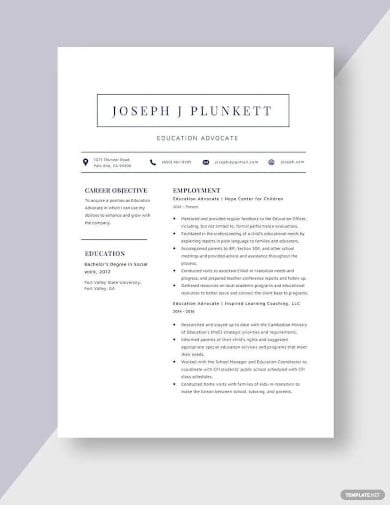
- Apple Pages
Free Education Officer Curriculum Vitae Template
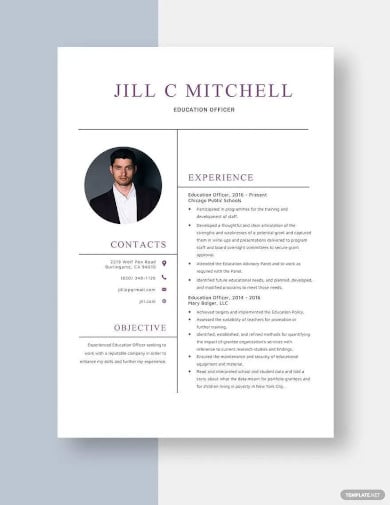
Education Teacher Curriculum Vitae Template
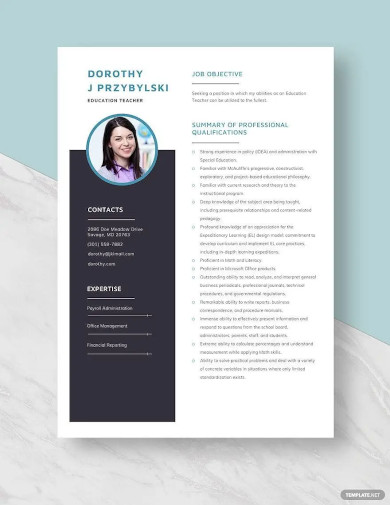
Education Specialist Curriculum Vitae Template

Administration CV Template
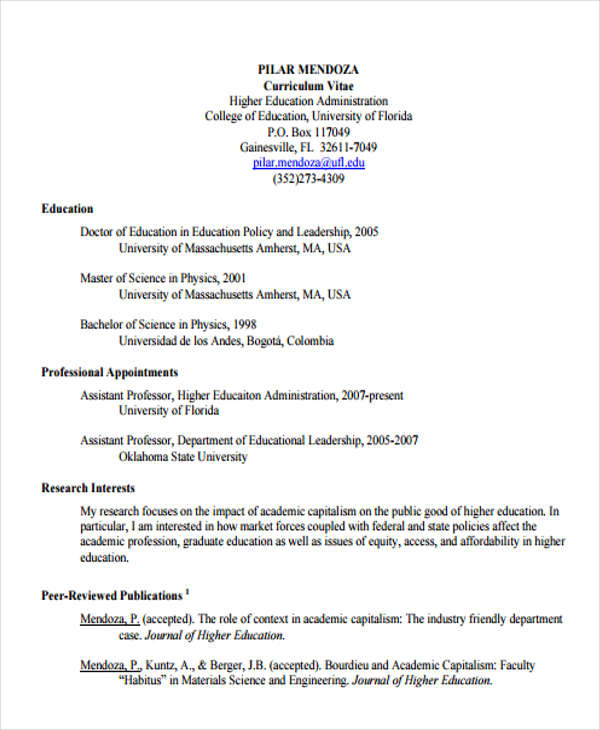
College Education CV Template
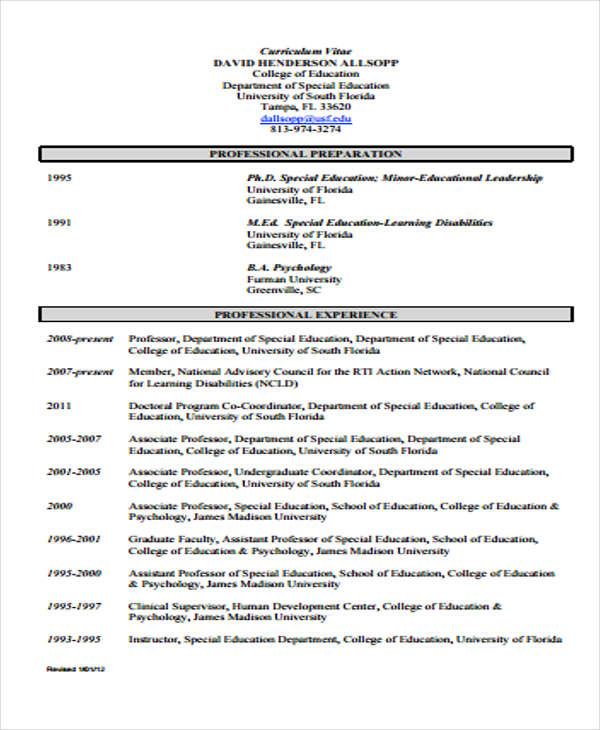
Free Physical Curriculum Vitae
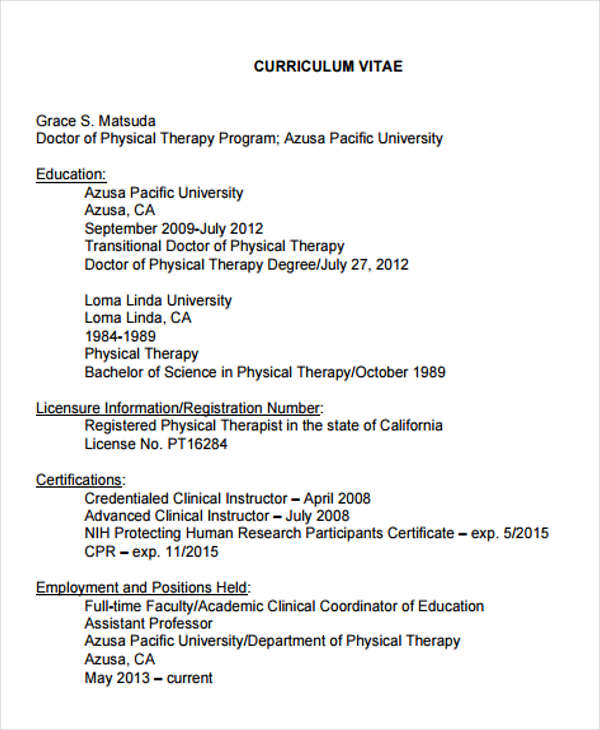
Free Musical Education
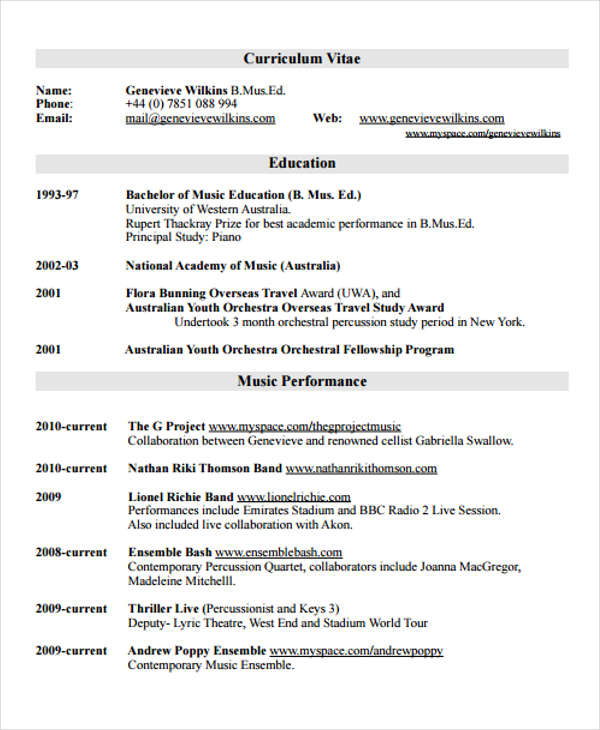
1. What Is an Education Curriculum Vitae?
- An administration curriculum vitae is used by applicants who would like to have an administrative position in an academic institution.The administrative Job description that may be given to a qualified candidate varies on the administrative support needed by the school that they want to be a part of.
- A college education curriculum vitae is used by a professor who would like to teach students that are in their tertiary level of education. Professors who would like to apply for college program teaching are usually required to have their Master’s degrees.
- A musical education curriculum vitae is applicable to be used by applicants who would like to teach music may it be through voice lessons or the use of various musical instruments. Musical education is usually offered by academies or art institutions that are focusing on the specific discipline.
Academic CV Template

Free Professional CV Template
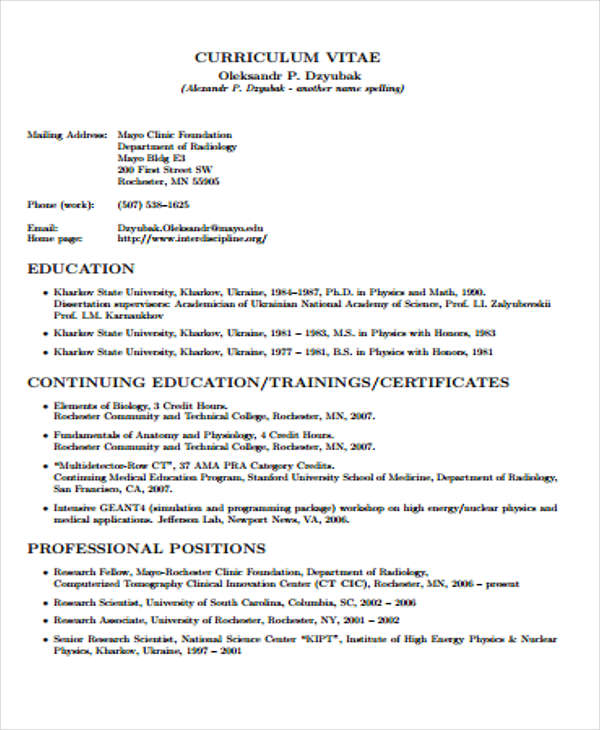
Teacher Curriculum Vitae

Education and Unemployment CV
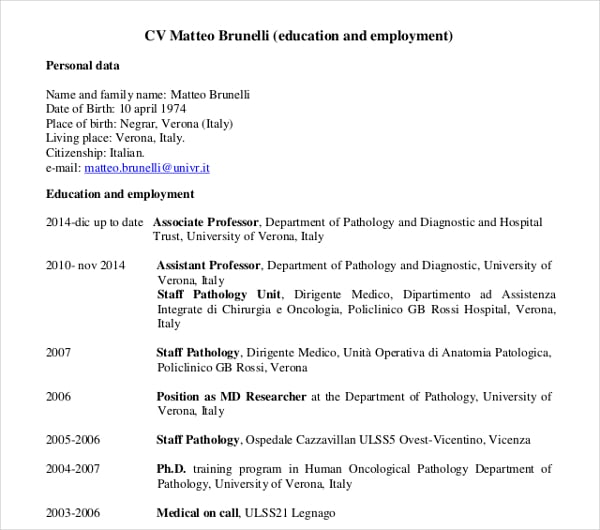
Free Sample Education CV
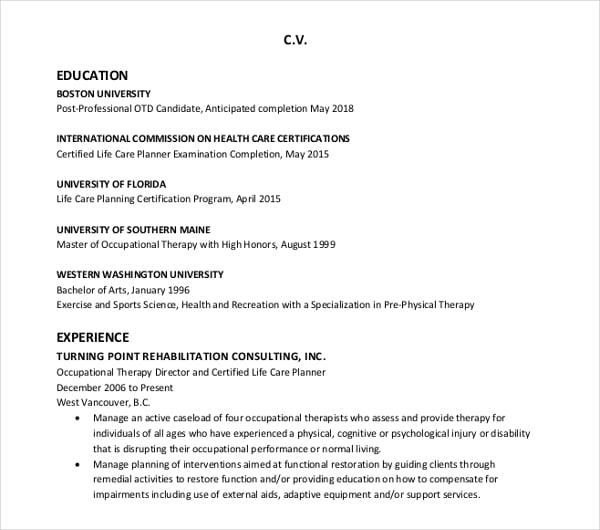
Short Education CV
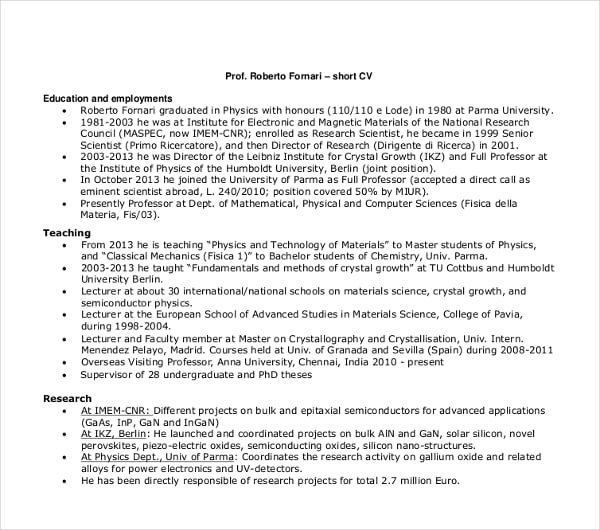
2. Guidelines in Creating an Education Curriculum Vitae
- Look for an appropriate template that you will use as a reference in creating an education curriculum vitae. This will help you to assure that your education curriculum vitae is formatted in a formal manner.
- Assure that you will highlight your educational attainment and achievements. Since you are applying for a job position in the field of academics, it is very important for you to have an impressive educational background.
- Make sure that you will include your experiences in teaching which includes the academic institutions where you have taught, the teaching positions that were given to you, the educational level of the students that you have handled, and your expertise in the field of teaching.
- Create an education curriculum vitae that will give focus on your knowledge and familiarity with different teaching systems and education processes.
More in Resume
15+ education curriculum development template bundle, marketing brand education curriculum template, school staff non-disclosure agreement template, school staff code of conduct template, school staff training needs assessment template, school staff probationary period evaluation form template, school staff skills gap analysis template, school staff behavior improvement plan template, school staff progress monitoring report template, school staff key performance indicator (kpi) template.
- 12+ HR Fresher Resume Templates
- 21+ Fresher Resume Templates
- 21+ Nurse Resume Templates – PDF, DOC
- 39+ Accountant Resumes in Doc
- 19+ Doctor Resume Templates – PDF, DOC
- 7+ Fresher Accountant Resumes
- 36+ Resume Format – Word, PDF
- 47+ Engineering Resume Templates in Word
- 13+ Computer Science Resume Examples
- 28+ Fresher Resume Templates in Word
- 10+ IT Fresher Resumes
- 48+ Resume Formats in PDF
- 50+ Best Resume Templates to Download
- 3+ Recruitment Consultant CV Templates in PDF
- 12+ Logistics Resume Templates in PDF | MS Word | Apple Pages
File Formats
Word templates, google docs templates, excel templates, powerpoint templates, google sheets templates, google slides templates, pdf templates, publisher templates, psd templates, indesign templates, illustrator templates, pages templates, keynote templates, numbers templates, outlook templates.
Purdue Online Writing Lab Purdue OWL® College of Liberal Arts
Writing the Curriculum Vitae

Welcome to the Purdue OWL
This page is brought to you by the OWL at Purdue University. When printing this page, you must include the entire legal notice.
Copyright ©1995-2018 by The Writing Lab & The OWL at Purdue and Purdue University. All rights reserved. This material may not be published, reproduced, broadcast, rewritten, or redistributed without permission. Use of this site constitutes acceptance of our terms and conditions of fair use.
This handout provides an overview of strategies for writing an effective curriculum vitae. This topic is particularly important for graduate students who are entering the academic job market for the first time. Although there is some overlap between the two resources, this handout should serve as a supplement to the suggestions available from Purdue's Center for Career Opportunities .
What is a Curriculum Vitae?
Also called a CV or vita, the curriculum vitae is, as its name suggests, an overview of your life's accomplishments, most specifically those that are relevant to the academic realm. In the United States, the curriculum vitae is used almost exclusively when one is pursuing an academic job. The curriculum vitae is a living document, which will reflect the developments in a scholar/teacher's career, and thus should be updated frequently.
How is a CV different from a resume?
The most noticeable difference between most CVs and most resumes is the length. Entry level resumes are usually limited to a page. CVs, however, often run to three or more pages. (Remember, however, that length is not the determinant of a successful CV. You should try to present all the relevant information that you possibly can, but you should also try to present it in as concise a manner as possible.) A more subtle but equally important distinction is that whereas the goal of a resume is to construct a professional identity, the goal of a CV is quite specifically to construct a scholarly identity. Thus, your CV will need to reflect very specifically your abilities as a teacher, researcher, and publishing scholar within your discipline.
What should I include?
Your CV should include your name and contact information, an overview of your education, your academic and related employment (especially teaching,editorial, or administrative experience), your research projects (including conference papers and publications), and your departmental and community service. You should also include a reference list, either as part of your CV, or on a separate page. Also, if you have a dossier containing confidential references available, you should mention that on your CV as well.
What comes first depends both on your background and on the job for which you are applying. Typically, the first item on a CV for a job candidate directly out of grad school will start with the candidate's education listed in reverse chronological order. Frequently the title and even a brief description of the dissertation will be included in this portion. After that, you will want to determine both what the jobs that you are interested in require and where your strengths lie. When determining what comes after your educational credentials, remember that the earlier in your document a particular block of information comes, the more emphasis you will be placing on that block of information. Thus, the most important information should come first.
If you are applying at a research university, research projects, conference presentations, and especially publications become very important. If you are applying to a liberal arts college or community college that strongly emphasizes teaching, then showing your teaching background is of paramount importance. In any case, you will want to be sure that the information that will be most helpful in determining your qualifications for the job for which you are employing comes before information that will be less helpful.
Is there a standard curriculum vitae format?
One of the most important things to remember when working on your curriculum vitae is that there is not one standard format. There are different emphases in each discipline, and a good CV is one that emphasizes the points that are considered to be most important in your discipline and conforms to standard conventions within your discipline.
So how can you find out what these conventions are? A good place to start is to find as many examples as possible of CVs by people in your discipline who have recently been on the job market. You can find these by asking other grad students and junior faculty in your department if you can have a look at their CVs, and you can also make use of the Internet to find CV samples in your discipline.
Resources such as The Curriculum Vitae Handbook by Rebecca Anthony and Gerald Roe (Rudi Publishing: Iowa City, 1994) also include sample CVs for various disciplines. One caveat to remember regarding examples, however, is that they should never be used as models to be followed in every detail. Instead, they should be used as sources of strategies for how to present your own information most effectively. The most effective formatting for you will likely be distinguishable from the most effective formatting for someone else because your experiences and strengths will be different, and you will thus benefit from formatting adapted specifically to your situation.
How should I construct my work description entries?
Two common strategies that apply to CVs as well as resumes are gapping and parallelism . Gapping is the use of incomplete sentences in order to present your information as clearly and concisely as possibly. For example, instead of writing, "I taught composition for four years, during which time I planned classes and activities, graded papers, and constructed exams. I also met with students regularly for conferences," you might write, "Composition Instructor (2000-2004). Planned course activities. Graded all assignments. Held regular conferences with students." By using incomplete sentences here, you cut out unnecessary words and allow your reader to see quickly what you have been doing.
Parallelism is also very important to a strong CV. Generally, you will want to keep the structure of your phrases and/or sentences consistent throughout your document. Thus, if you use verb phrases in one portion of your CV to describe your duties, try to use them throughout your CV. Particularly within entries, make sure that the structure of your phrases is exactly parallel so that your reader can understand what you are communicating easily.
One distinction between the work description sections of resumes and CVs is that bullets are very commonly used in resumes and tend to appear somewhat less frequently in CVs. Whether or not you use bullets to separate lines in your CV should depend on how the bullets will affect the appearance of your CV. If you have a number of descriptive statements about your work that all run to about a line in length, bullets can be a good way of separating them. If, however, you have a lot of very short phrases, breaking them up into bulleted lists can leave a lot of white space that could be used more efficiently. Remember that the principles guiding any decision you make should be conciseness and ease of readability.
How can I improve my CV?
The Purdue On-Campus Writing Lab provides the opportunity to work with one of our graduate instructors in order to get some assistance with your CV, and many other universities offer similar opportunities through their writing centers. Also, consider showing your CV to your dissertation chair in order to get some feedback from him/her. Finally, many departments have job search or job placement committees that provide you with the opportunity to meet with faculty members in your department for extensive editing. If such a resource is available for you, that may be the best source of advice of all.
What other resources are available for help with my curriculum vitae?
There are numerous useful resources, both online and in print. Here are a few.
The Chronicle of Higher Education 's job site features a number of articles that may be helpful to first-time applicants on the job market.
The Curriculum Vitae Handbook by Rebecca Anthony and Gerald Roe (Rudi Publishing: Iowa City, 1994) includes sample CVs for various disciplines and tips for how to write CVs in various contexts.
The Academic Job Search Handbook (3rd Edition), by Mary Morris Heiberger and Julia Miller Vick (who are the authors of the Chronicle 's "CV Doctor" column) also provides sample cover letters and CVs

IMAGES
VIDEO
COMMENTS
See our academic CV template and learn which academic CV format you must follow to get the faculty job you want. Our academic CV examples will guide the way. ... See a properly written sample academic curriculum vitae education section: Education on an Academic CV—Example. 2017 MA in French. The Department of Romance Languages and Literatures.
How to write an education section on a CV. Here are six steps you can follow to write the education portion of your CV: 1. Include the name and location of any schools attended. Providing the name and location of the school you attended provides the hiring manager or reader with an understanding of your level of education.
As a school leaver hoping to land a job, it's likely that your GCSEs are going to be your highest level of qualification. When adding these to your CV, you should include the full name of your school and the dates you attended. Underneath this, you can begin to outline your GCSEs. Example 1. Example 2.
Here is a template to follow when writing an education section for your CV: Education. [Degree and major] | [Name of school or university] [City], [County] Certification (optional) [Certification name], [Host organisation] - [Year completed or expiration date] Extracurricular activities. [Activity]
2. Add a detailed education professional experience section. For each job in your recent work history, brainstorm your duties and achievements on a separate document or sheet of paper. Then, identify and copy the most relevant details into your resume's experience section. This approach keeps your resume concise and focused.
Here's an example of a resume with the education section featured near the top: If you have more than a couple of years of relevant work experience, list your education below your work experience section. For most jobs, your education is less relevant to your ability to do the job than your hands-on work experience.
Use consistent format: Fonts in 11 or 12 points are easy to read and section headings should be two to four points larger, such as 13 to 16 points. You can use a one-inch margin for resume borders. Use action verbs: When describing your educational accomplishments, start each statement with an action verb.
Education resume summary example. Created and implemented 47 high-quality lesson plans over a 9-month period. Copy to clipboard. Numbers give employers insight into what you can achieve as a professional. Including them makes your application more believable (and compelling). 2. Highlight your teaching certifications.
Salary for the education industry depends on the specific job title. For example, The median income in 2021 for high school teachers was $61,820.00. The median income for instructional coordinators was $63,740.00 in 2021. The median wage for teaching assistants in 2021 was $29,360.00.
Make sure to use strong action verbs and keep the summary concise and focused on what makes you stand out from other candidates. Here are some other CV samples that could help you to come up with a great range of ideas for your education CV: Teacher CV sample. Teaching assistant CV example. Headteacher CV sample.
Education CV Template. 1.) Contact Information. Full Name. ... To make your Education CV stand out, highlight your teaching achievements, innovative methods, and student outcomes. Include any specialized training, certifications, or expertise in educational technology. Showcase your ability to adapt to different learning styles and manage ...
Essential CV Sections for Educations. Every education professional's CV should include these core sections to provide a clear, comprehensive snapshot of their professional journey and capabilities: 1. Personal Statement: A concise summary that captures your qualifications, educational expertise, and career goals. 2.
CV Education Examples—Other Types of Education and Qualifications. Education. Level 2 Diploma in Health and Social Care for England, September 2016-June 2017. Northside College, London. 10 GCSEs including maths and English, September 2014-June 2016. Wexford Academy, London. Certificates.
Add the degree earned if you completed it. Include the school name, city, and state. List the program or major if the schooling is yet unfinished. Add extras to make the education section soar, such as honours, awards, relevant coursework, and minors. Use a second educational entry if the first one is unfinished.
1. Name of institution. You should always write down your school/university/college name in the education history CV. 2. Location. Simply include the city and country where the institution is located. 3. Type of degree obtained. State which degree/certification you received.
Related: CV format guide: examples and tips Relevant information for the education section of your CV Whichever order you choose to list education and employment, there are several ways to format the education section, depending on your background: School leavers Include both your A-level and GCSE results.
There are a few fundamentals the recruiter will expect to see in the education section of your CV. They include: Name of the institution - school, college, or university. Qualification with grades. Dates of attendance or the year the qualification was awarded. If you're a recent university graduate, you should also include details of relevant ...
Listing your education on a resume should be strategic and concise. It's essential to highlight the most relevant and recent educational experiences that align with the job requirements. Focus on providing key details such as the degree earned, institution name and graduation year. Emphasize any honors, scholarships or academic achievements ...
14+ Education Curriculum Vitae Templates. An education curriculum vitae is used by candidates who would like to practice their expertise in the field of education. Mostly, an education curriculum vitae sample is beneficial to professional work applicants who are into teaching, guidance counseling, and academic training.
Writing the Curriculum Vitae. This handout provides an overview of strategies for writing an effective curriculum vitae. This topic is particularly important for graduate students who are entering the academic job market for the first time. Although there is some overlap between the two resources, this handout should serve as a supplement to ...